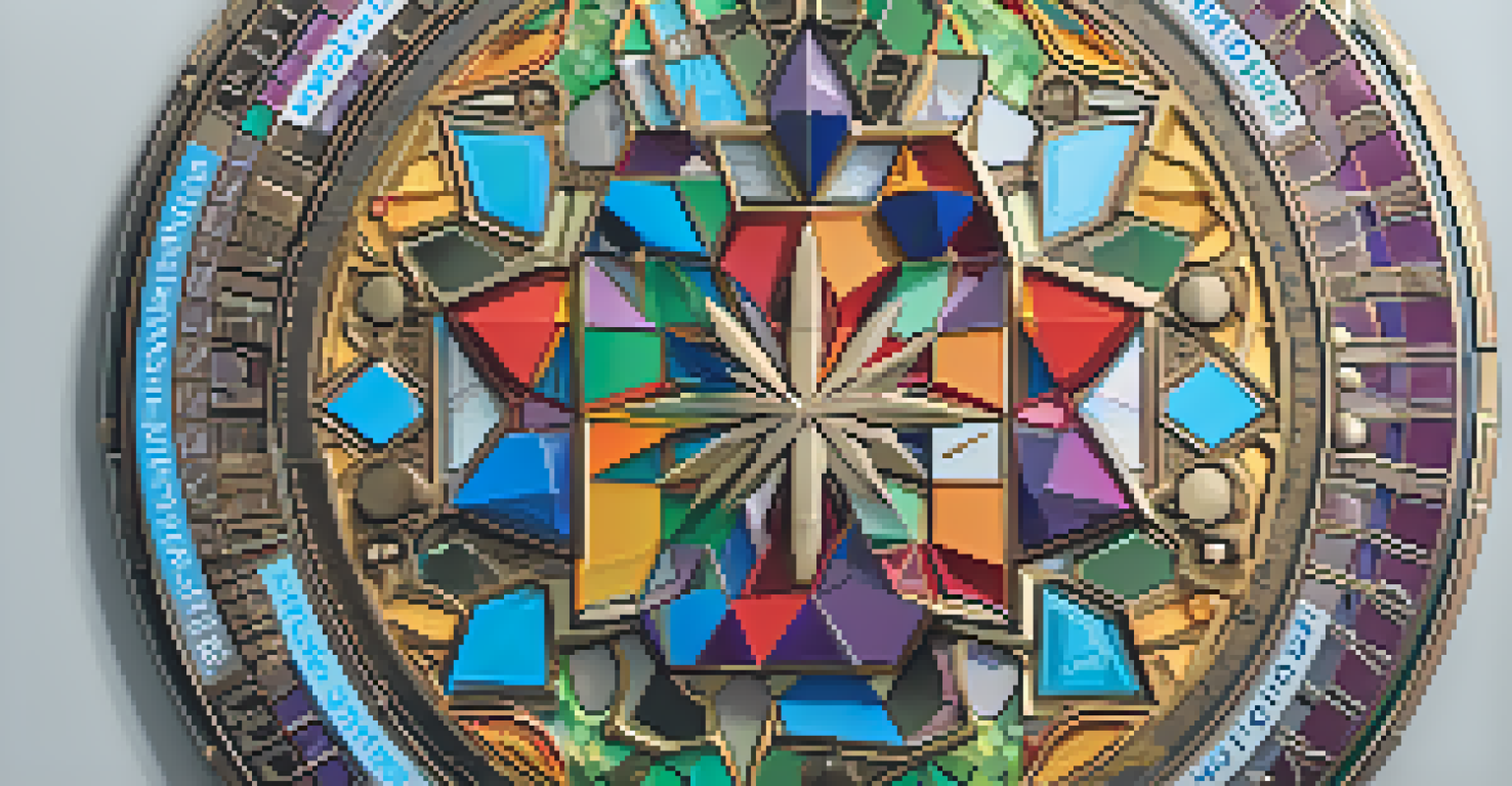Token Standards: ERC-20 vs ERC-721 in Ethereum Ecosystem

What Are Token Standards in the Ethereum Ecosystem?
Token standards are essential guidelines that dictate how tokens behave on the Ethereum blockchain. Essentially, they provide a framework for creating and managing tokens, ensuring compatibility and interoperability within the ecosystem. By adhering to these standards, developers can streamline their processes, creating tokens that reliably interact with wallets, exchanges, and other smart contracts.
Tokens are the lifeblood of decentralized applications, providing the necessary incentives and interactions that power the Ethereum ecosystem.
Two of the most prominent standards in Ethereum are ERC-20 and ERC-721. While both serve to define the structure of tokens, they cater to different use cases. Understanding these standards is crucial for anyone looking to delve into the world of Ethereum-based applications and blockchain technology.
ERC-20 is the go-to standard for fungible tokens, meaning each token is identical and interchangeable. In contrast, ERC-721 is designed for non-fungible tokens (NFTs), where each token has unique properties. This distinction is fundamental to grasping how various types of tokens operate within the Ethereum ecosystem.
Diving Deeper into ERC-20 Tokens
ERC-20 tokens are the backbone of many projects in the Ethereum ecosystem, primarily because they represent fungible assets. This means that each token can be exchanged on a one-to-one basis, much like a dollar bill or a standard unit of currency. For example, if you have one ERC-20 token, you can easily swap it for another token of the same type without any loss of value.

One crucial aspect of ERC-20 is its standardized functions, which include transferring tokens, checking balances, and approving transactions. These functions simplify development and ensure that all ERC-20 tokens can interact seamlessly with Ethereum wallets and decentralized applications (dApps). This uniformity has led to a proliferation of ERC-20 tokens, fueling various decentralized finance (DeFi) projects.
Understanding Token Standards
Token standards like ERC-20 and ERC-721 provide essential guidelines for creating and managing tokens on the Ethereum blockchain.
Popular examples of ERC-20 tokens include Tether (USDT) and Uniswap (UNI). These tokens have gained significant traction, showcasing the versatility and utility of the ERC-20 standard in creating digital currencies that can be easily traded and utilized across the Ethereum network.
The Unique Features of ERC-721 Tokens
ERC-721 tokens introduce a distinct concept of non-fungibility, setting them apart from ERC-20 tokens. Each ERC-721 token is unique and can represent ownership of a specific asset, whether digital art, collectibles, or even virtual real estate. Think of it like owning a one-of-a-kind painting; no two are identical, and each has its own unique value.
The future of NFTs is not just about digital art; it’s about creating a new way to establish ownership and value in the digital world.
The ERC-721 standard allows for the minting of these unique tokens, enabling creators to establish provenance and ownership. This is particularly significant in the realm of digital art, where artists can sell their work as NFTs, providing them with a new revenue stream and ensuring that they receive credit for their creations.
High-profile sales, such as the digital artwork by Beeple that sold for $69 million, have propelled ERC-721 tokens into the limelight. As more creators and collectors recognize the value of unique digital assets, the demand for ERC-721 tokens continues to soar, showcasing the transformative potential of blockchain technology.
Comparing Use Cases: ERC-20 vs. ERC-721
When it comes to use cases, ERC-20 and ERC-721 tokens serve different purposes within the Ethereum ecosystem. ERC-20 tokens are typically used for creating cryptocurrencies, utility tokens, or stablecoins, which can be easily traded and exchanged. Their fungibility makes them ideal for various applications in the DeFi space, such as lending platforms and decentralized exchanges.
On the other hand, ERC-721 tokens cater to the growing market for unique digital assets, particularly in areas like gaming and art. These tokens allow users to own, trade, and showcase one-of-a-kind items that cannot be replicated or exchanged on a one-to-one basis. This uniqueness adds a layer of excitement and engagement for collectors and enthusiasts.
Distinct Use Cases for Tokens
ERC-20 tokens are designed for fungible assets, while ERC-721 tokens cater to unique digital assets, highlighting their different applications.
By understanding these different use cases, developers and investors can make informed decisions about which token standard best suits their goals. Whether aiming to create a new cryptocurrency or a unique digital collectible, knowing the strengths of ERC-20 and ERC-721 is key to successful projects.
Interoperability Between ERC-20 and ERC-721 Tokens
Interoperability is a crucial aspect of the Ethereum ecosystem, allowing different tokens to interact and function together. While ERC-20 and ERC-721 tokens have distinct characteristics, they can coexist and complement each other within decentralized applications. For example, an NFT marketplace might use ERC-20 tokens for transactions while showcasing unique items represented by ERC-721 tokens.
This interoperability fosters innovation, enabling developers to create multifaceted platforms that leverage both token types. Imagine a gaming platform where players earn ERC-20 tokens for completing tasks, which they can then use to purchase exclusive ERC-721 items like skins or weapons. This synergy enhances user experience and encourages engagement.
As the Ethereum ecosystem continues to evolve, the ability for different token standards to work together will drive the development of new applications and services. This interconnectedness is one of the reasons Ethereum has become a leading platform for blockchain projects, attracting developers and businesses alike.
Challenges Faced by ERC-20 and ERC-721 Tokens
Despite their popularity, both ERC-20 and ERC-721 tokens face challenges that developers must navigate. For ERC-20 tokens, issues like token supply limits, security vulnerabilities, and regulatory scrutiny can pose significant hurdles. Developers must be diligent in auditing their smart contracts to ensure they are secure and compliant with regulations.
Similarly, ERC-721 tokens also encounter unique challenges, particularly concerning scalability and interoperability. As the popularity of NFTs grows, so do the concerns about network congestion and high transaction fees on Ethereum. Developers are now exploring layer-2 solutions and alternative blockchains to mitigate these issues and enhance user experience.
Future Innovations in Token Standards
The evolution of token standards in Ethereum promises enhanced scalability and new use cases, paving the way for exciting developments in the ecosystem.
Understanding these challenges is crucial for anyone looking to develop or invest in token projects. By being aware of the potential pitfalls, developers can strategize effectively, while investors can make informed decisions that align with their risk tolerance and objectives.
The Future of Token Standards in Ethereum
The future of token standards in Ethereum appears bright, with ongoing developments and innovations on the horizon. As the Ethereum network undergoes upgrades and improvements, like the transition to Ethereum 2.0, we can expect enhanced scalability and reduced transaction fees. These advancements will further bolster the adoption of both ERC-20 and ERC-721 tokens.
Moreover, as new use cases for blockchain technology emerge, we may see the introduction of additional token standards tailored to specific needs. For example, standards that combine features of both ERC-20 and ERC-721 could offer hybrid solutions, catering to diverse applications in the ecosystem.

Ultimately, the evolution of token standards will continue to shape the Ethereum landscape, fostering creativity and innovation. By staying informed about these developments, developers and investors can position themselves to take advantage of the exciting opportunities that lie ahead.